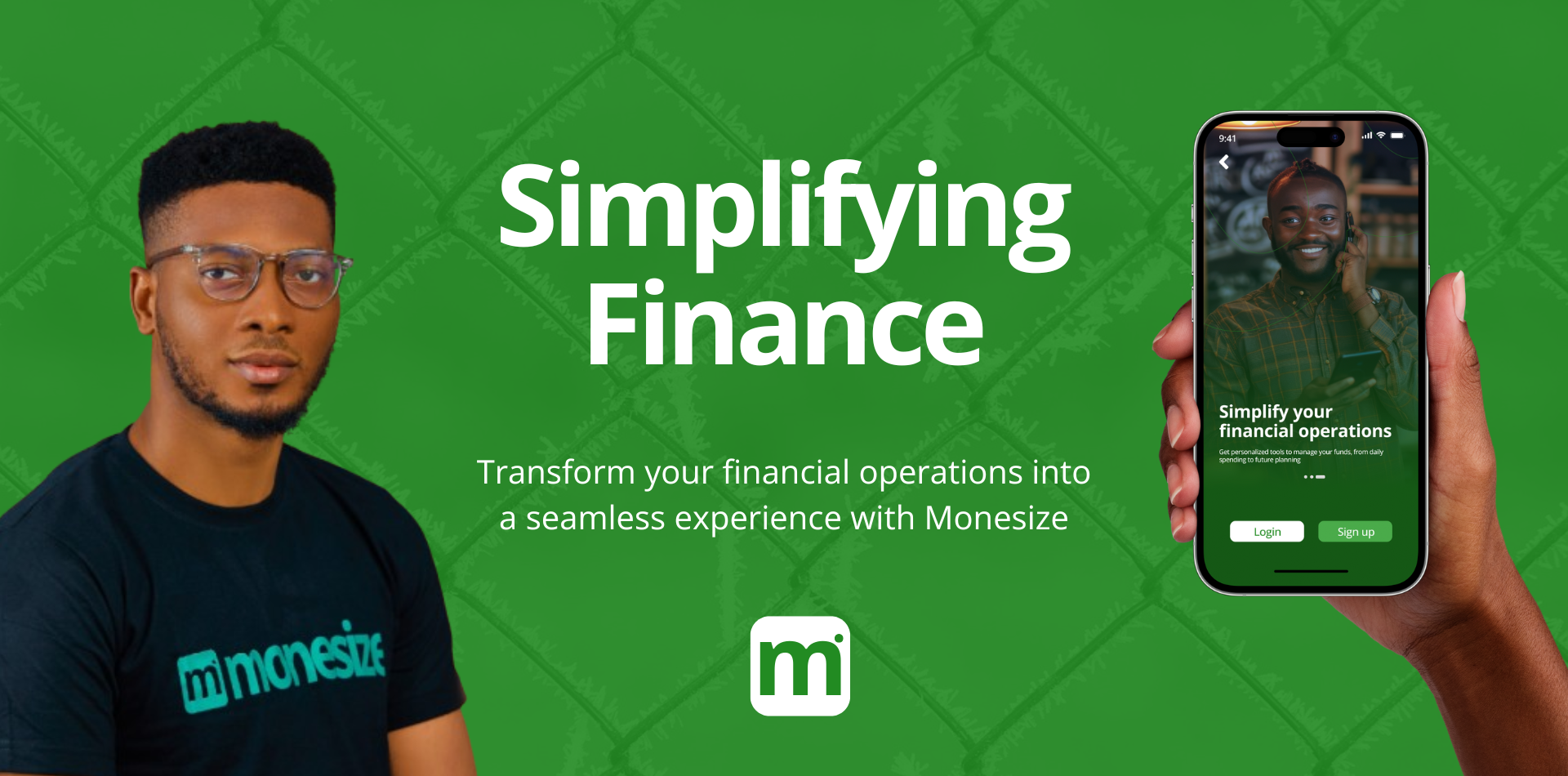My Dual Role: Shaping Monesize as Co-Founder and Backend Engineer
 David Oduse
David OduseTable of contents
- The Problem We Set Out to Solve
- Role of Technology in Solving These Pain Points
- My Journey as a Backend Engineer at Monesize
- 1. API Design and Implementation: Bridging the Frontend and Backend
- 2. Database Management and Optimization: Making Data Work for Us
- 3. Authentication and Authorization: Securing Access
- 4. Business Logic Development: Solving Real Problems
- 5. Security and Data Integrity: Protecting What Matters
- 6. Technological Innovation: Preparing for the Future
- 7. Collaboration and Documentation: Building for the Future
- The Way Forward…

Starting a business is an exciting journey, full of possibilities, but it also comes with significant challenges—especially when it comes to managing finances. I’ve always been passionate about using technology to solve real-world problems, and that’s how my journey with Monesize began.
The Problem We Set Out to Solve
Running a small or medium-sized enterprise (SME) can be a stressful endeavor. One of the biggest pain points for business owners is financial management. Many entrepreneurs find themselves overwhelmed with juggling business expenses, income tracking, subscriptions, team management, and most importantly, staying on top of financial insights to make informed decisions. The tools available for these tasks often either lack the depth required or are simply too complicated and expensive for small businesses to afford.
This is where Monesize comes in.
Monesize is being engineered with one purpose in mind: to simplify finance for small businesses. The idea is simple — create a platform where business owners can seamlessly track their financial data, manage their teams, analyze their business insights, and focus on growing their business without the constant stress of managing finances manually or using scattered, complex tools.
The mission behind Monesize is to disrupt how SMEs interact with their finances, offering an intuitive, user-friendly experience that allows them to manage and understand their money better. Whether it’s managing subscriptions, monitoring income, or getting AI-driven insights, Monesize is designed to empower entrepreneurs to make smarter financial decisions.
Role of Technology in Solving These Pain Points
One of the key innovations that Monesize brings to the table is automation. SMEs don’t have the luxury of hiring large teams of accountants or spending hours generating reports. Monesize leverages automation to help users track their transactions, manage budgets, and provide AI insights that make sense of their financial data in a way that’s actionable and relevant.
But this vision could not be achieved without a strong technological foundation. That's where I come in as a Co-founder, CEO, and Software Engineer. Wearing multiple hats, I am deeply involved in both the business side and the technical development of Monesize. Being the driving force behind the backend development, I focused on ensuring that the infrastructure was robust, scalable, and most importantly, secure.
My Journey as a Backend Engineer at Monesize
As a backend engineer, I had the privilege of building the foundation on which Monesize stands today. While it’s easy to get caught up in the glitz and glamour of front-end features, the real magic of any platform happens on the backend. Here’s a breakdown of my role and accomplishments at Monesize.
1. API Design and Implementation: Bridging the Frontend and Backend
One of the first major challenges I faced was designing and implementing the RESTful APIs that power Monesize. The APIs are the backbone of the platform, allowing the frontend to communicate with the backend seamlessly. This includes everything from user authentication and business profile management to transaction tracking and team invitations.
I used Express.js for routing and Sequelize for interacting with our PostgreSQL database, ensuring efficient data flow. These APIs are not just basic endpoints; they handle everything that is crucial to the platform’s functionality. This meant developing secure endpoints for:
User data management (including role-based access for different team members like Admins, Members, and Viewers).
Subscription management to ensure users’ premium features were properly handled.
Team invitations with token-based verification for secure onboarding.
This allowed us to offer a streamlined experience for users who could access their dashboards, manage their businesses, and collaborate with their teams—all without worrying about the underlying complexities.
2. Database Management and Optimization: Making Data Work for Us
A large part of my role involved designing and managing the PostgreSQL database schema. The key here was to ensure that data was organized in a way that made it both easy to access and easy to scale as the platform grew. Our database houses a wealth of information, from user profiles and transactions to businesses and their associated budgets.
I utilized Sequelize ORM to build and maintain the relationships between the key entities. For example:
Users to businesses: Each user could own multiple businesses, but each business could also have many users as team members.
Transactions to receipts: Every transaction could have an associated receipt, making it easy to keep track of financial records.
Projects to budgets: Businesses could track projects and their associated budgets, which is essential for small business owners who need to understand their expenses.
Optimizing database queries, improving performance, and setting up database migrations with Sequelize CLI were crucial in ensuring the system could handle the increasing amount of data as Monesize scaled.
3. Authentication and Authorization: Securing Access
Security has always been a top priority. One of the key pieces of functionality I worked on was the JWT-based authentication system. This allowed users to securely log in and access their personalized dashboards.
What makes Monesize unique is the role-based access control (RBAC) feature, which ensures that only authorized users can access specific business data. Whether it's viewing financial reports or inviting new team members, every user’s permissions are carefully managed.
4. Business Logic Development: Solving Real Problems
One of my most rewarding tasks was developing the business logic that ensures Monesize’s features are both intuitive and practical. For instance, I created a feature that prevents business owners from creating duplicate business profiles with the same name, but also allows different users to have businesses with identical names. This simple yet crucial logic helps ensure that the platform remains organized and avoids confusion among users.
Another feature I implemented was email invitations for team members. Business owners can invite people to join their teams with specific roles like admin, member, or viewer. I implemented a secure, token-based verification system, ensuring that only invited users could join and access the business data.
Finally, I developed a custom timeframe transaction view, which allows users to filter their financial data based on specific periods, making it easier to track income and expenses over time. This helped elevate the user experience, giving business owners better insights into their cash flow.
5. Security and Data Integrity: Protecting What Matters
Keeping financial data secure was one of my highest priorities. I worked extensively on ensuring that sensitive information was encrypted and validated before entering the system. Robust error handling and validation mechanisms were implemented throughout the system to prevent data corruption and ensure integrity.
For example, when processing transactions, it was essential to ensure that every request was valid, and data was consistent across the system. This helped prevent issues like duplicate transactions or incorrect data being recorded.
6. Technological Innovation: Preparing for the Future
Monesize isn’t just about managing finances; it’s about making smarter financial decisions. To help our users achieve this, we are integrating AI-powered insights that provide businesses with actionable data and trends. As part of my role, I’m working on the backend systems to collect and process this data, ensuring it was accurate and up-to-date.
I’m also contributing to the development of features that allow users to export data and generate reports, helping them present their financial data in a way that is both understandable and useful for decision-making.
7. Collaboration and Documentation: Building for the Future
Being a part of a startup means wearing many hats, and collaboration is key. I worked closely with our frontend, product and design team, ensuring that APIs were well-integrated and that the user interface was both seamless and responsive.
I also focused on documenting the APIs and the overall system architecture. This ensures that future engineers can easily understand and contribute to the platform, which is crucial for a growing company.
The Way Forward…
Looking back at my journey with Monesize, I’m incredibly proud of what we’ve built, and currently building. As a backend engineer, I’ve had the opportunity to shape the technical infrastructure of a platform poised to help millions of small businesses manage their finances with ease. The combination of technical expertise and a user-first approach is what sets Monesize apart, and I’m excited about where we’re headed next.
Whether it’s through improving AI-driven insights, expanding team collaboration features, or enabling businesses to access more robust financial data, Monesize is changing the way SMEs operate — and I’m thrilled to be a part of it.
As we continue to grow, I’m confident that Monesize will be the go-to platform for business owners who want to take control of their financial future.
This article encapsulates my role at Monesize, highlighting the technical challenges and solutions I worked on. But above all, it speaks to the impact we’re making—simplifying finance and empowering businesses to thrive. After all, it's not just about building great software; it's about building software that matters.
Subscribe to my newsletter
Read articles from David Oduse directly inside your inbox. Subscribe to the newsletter, and don't miss out.
Written by

David Oduse
David Oduse
David is a Senior Backend Engineer at Monesize, passionate about impacting the world through tech solutions to numerous human problems.